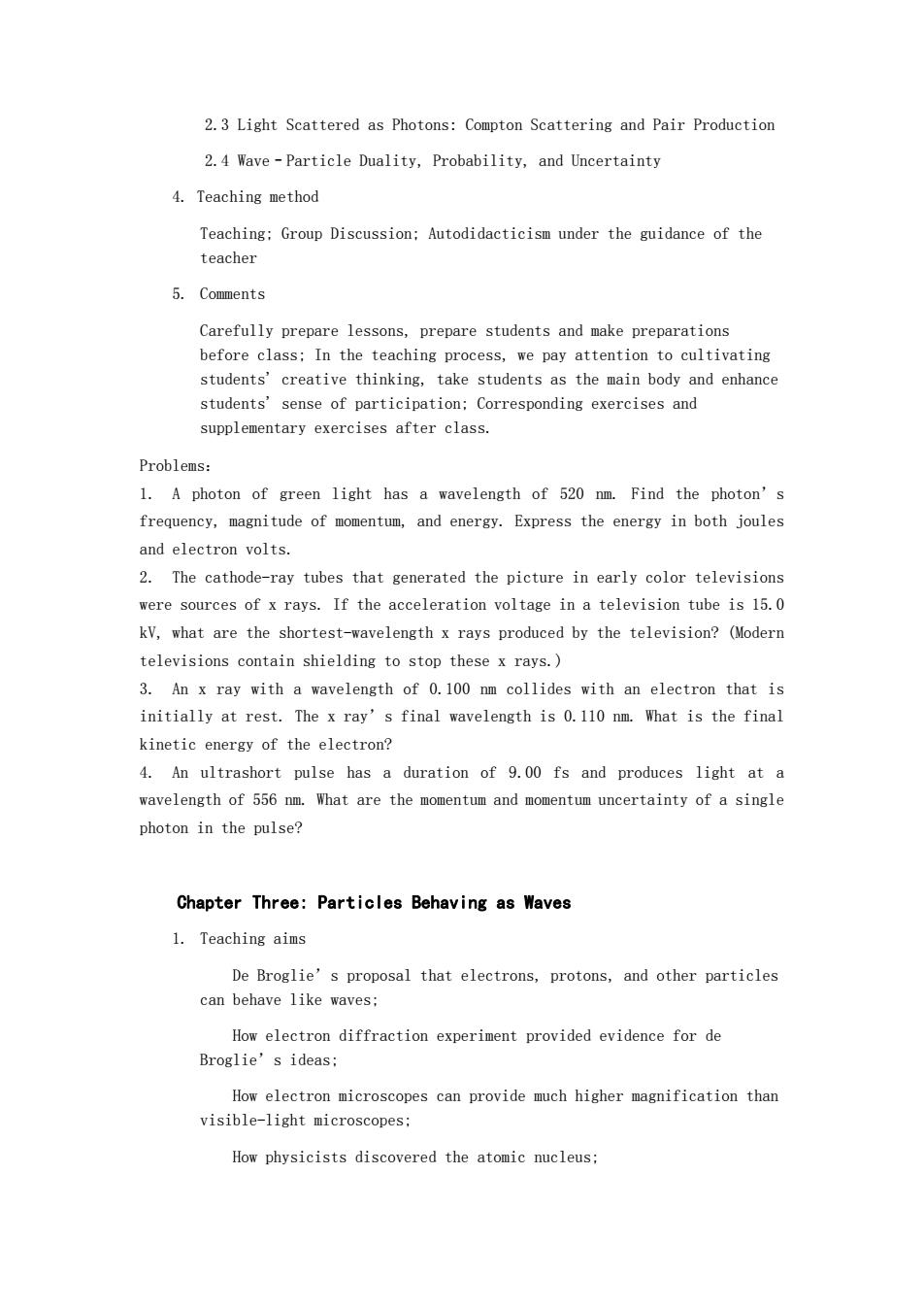正在加载图片...

2.3 Light Scattered as Photons:Compton Scattering and Pair Production 2.4 Wave-Particle Duality,Probability,and Uncertainty 4.Teaching method Teaching:Group Discussion:Autodidacticism under the guidance of the teacher 5.Comments Carefully prepare lessons,prepare students and make preparations before class:In the teaching process,we pay attention to cultivating students'creative thinking,take students as the main body and enhance students'sense of participation:Corresponding exercises and supplementary exercises after class. Problems: 1.A photon of green light has a wavelength of 520 nm.Find the photon's frequency,magnitude of momentum,and energy.Express the energy in both joules and electron volts 2.The cathode-ray tubes that generated the picture in early color televisions were sources of x rays.If the acceleration voltage in a television tube is 15.0 kV,what are the shortest-wavelength x rays produced by the television?(Modern televisions contain shielding to stop these x rays.) 3.An x ray with a wavelength of 0.100 nm collides with an electron that is initially at rest.The x ray's final wavelength is 0.110 nm.What is the final kinetic energy of the electron? 4.An ultrashort pulse has a duration of 9.00 fs and produces light at a wavelength of 556 nm.What are the momentum and momentum uncertainty of a single photon in the pulse? Chapter Three:Particles Behaving as Waves 1.Teaching aims De Broglie's proposal that electrons,protons,and other particles can behave like waves; How electron diffraction experiment provided evidence for de Broglie's ideas; How electron microscopes can provide much higher magnification than visible-light microscopes: How physicists discovered the atomic nucleus2.3 Light Scattered as Photons: Compton Scattering and Pair Production 2.4 Wave–Particle Duality, Probability, and Uncertainty 4. Teaching method Teaching; Group Discussion; Autodidacticism under the guidance of the teacher 5. Comments Carefully prepare lessons, prepare students and make preparations before class; In the teaching process, we pay attention to cultivating students' creative thinking, take students as the main body and enhance students' sense of participation; Corresponding exercises and supplementary exercises after class. Problems: 1. A photon of green light has a wavelength of 520 nm. Find the photon’s frequency, magnitude of momentum, and energy. Express the energy in both joules and electron volts. 2. The cathode-ray tubes that generated the picture in early color televisions were sources of x rays. If the acceleration voltage in a television tube is 15.0 kV, what are the shortest-wavelength x rays produced by the television? (Modern televisions contain shielding to stop these x rays.) 3. An x ray with a wavelength of 0.100 nm collides with an electron that is initially at rest. The x ray’s final wavelength is 0.110 nm. What is the final kinetic energy of the electron? 4. An ultrashort pulse has a duration of 9.00 fs and produces light at a wavelength of 556 nm. What are the momentum and momentum uncertainty of a single photon in the pulse? Chapter Three: Particles Behaving as Waves 1. Teaching aims De Broglie’s proposal that electrons, protons, and other particles can behave like waves; How electron diffraction experiment provided evidence for de Broglie’s ideas; How electron microscopes can provide much higher magnification than visible-light microscopes; How physicists discovered the atomic nucleus;